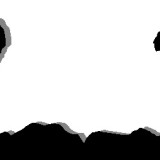What is Palestine? Who are the Palestinians?
The Arab-Israeli conflict is presented in the media as a territorial dispute, a common argument asserts that in the territory of the present state of Israel they’re used to reside thousand-year-old
Arab Palestinian people which was forcibly evicted by the Zionist Jews.
In order to evaluate these claims we must examine the historical facts we shall do this in what follows.
It was the Romans who in the second century of the Common Era first used the name Syria Palestina for Jerusalem and surrounding areas. It was an incorrect usage in Greek Palestina means homeland of the Philistines, but the Philistines never occupied more than a tiny sliver on the eastern Mediterranean coast including part of what is todays the Gaza Strip and they had ceased to exist centuries earlier.
The Romans had conquered a place called Kingdom of Judah and they themselves after possessing it call it province of Judea, both names mean homeland of the Jews.
Why then did the Romans change the name to Syria Palestina? This is an important question.
Jewish community and religion are organized around the law of Moses which according to exodus was born in an Egyptian slave revolt and this explains why the law of Moses denounces oppression and protects the poor, it also explains the preoccupations of the Roman military aristocracy, in those days the Jews were very large population distributed throughout the Mediterranean. The greatest worry of the Romans was that the popularit
y of the Law of Moses among the oppressed peoples of the empire might result in revolution.
In order to avoid such an outcome the Empire launched enormous mass killings of Jews remembered today as the first Jewish War, the Diaspora Revolt, and the second Jewish War. According to historians, taken together and in proportional terms, the Romans killed perhaps more Jews than did Adolf Hitler once the genocides had been concluded. Emperor Hadrian, after destroying Jerusalem in the second century, brought Greeks to settle it and forbade the entrance to Jews under pain of death. The city was renamed Aelia Capitolina and the area Syria Palestina. In political terms Palestine means there are no Jews here nor do we allow them.
Some Jews stubbornly remained in the Holy Land and many others soon returned the Romans informally continued to call the place Judea. With the passing at the centuries the name Palestine was used less and less and seized to have a clear referent. Under the Turkish Ottoman Empire, overlord of the area from the 16th century, there was no administrative or political entity called Palestine.
In the 20th century after wrenching the Middle East from the Turks in World War 1 the British revived the name when they created the British Mandate for Palestine. But their final definition of Palestine in 1922 was just 1/4th of the land mass that they themselves had baptized Palestine two years before.
Such arbitrariness supports the complaint of Arab historian Philip Hitti who testified in 1946 before the Anglo-American committee of inquiry that there is no such thing as Palestine in history, absolutely not!
But if the name Palestine is an artificial creation of the Roman Empire and later of the British Empire then who are the so-called Palestinians? That question was answered by the Zahir Muhsein the chief of military operations of the Palestine Liberation Organization or P.L.O. now better known as the Palestinian Authority. In an interview with Dutch magazine Trauw, Muhsein explained:
“We are all part of ONE people, the Arab nation… We are one people. Just for political reasons we carefully underwrite our Palestinian identity. Because it is of national interest for the Arabs to advocate the existence of Palestinians to balance Zionism.”
“Yes, the existence of a separate Palestinian identity exists only for tactical reasons. The establishment of a Palestinian state is a new tool to continue the fight against Israel and for Arab unity.”
Why does Muhsein say a new tool to continue the fight against Israel? In war after war the combined efforts of several Arab Muslim states were defeated by tiny Israel again and again, so a new tool was needed, a political warfare strategy that combined terrorism with diplomacy to achieve what open warfare could not.
But is Zahir Muhsein saying that the Palestinian people with the presumed right to the land the Jewish state was simply invented? The PLO charters appear to confirm this.
In its first charter dated 1964 the PLO defined Palestine in article 2 with its boundaries at the time at the British Mandate. This is a reference to the second arbitrary definition at the British from 1922. How can a twentieth-century foreign colonial power arbitrarily define the boundaries of the supposedly ancestral land of the Palestinians? But in truth the PLO did not even really adopt the British definition in Article 24 the PLO explicitly asserted the Judea, Samaria and Gaza the territories which it now claims for its desired state were not Palestinian.
“Article 24: This organization does not exercise any territorial sovereignty over the West Bank (Judea and Samaria) in the Hashemite Kingdom of Jordan or on the Gaza Strip. “
In 1968 the PLO rewrote its charter, this time the definition of Palestine did not exclude Gaza, Judea and Samaria so the PLO was now claiming these territories. What explains the change?
In 1964 when the PLO wrote its first charter Egypt was illegally occupying Gaza and Jordan was illegally occupying Judea and Samaria. But then the Arab states provoked the war of 1967 or six-day war in which the Israelis captured the territories of Gaza, Judea and Samaria among others. It was after this that the PLO rewrote its constitution, in 1968, this time including Gaza, Judea and Samaria in its definition of Palestine.
The borders of Palestine are therefore flexible and are redrawn to surround exactly the territory which Israel controls. In other words, the borders of Palestine are chosen nearly so that it can be used as a tool to continue the fight against Israel.
But if Palestine is a recent invention and the same goes for the Palestinian identity, then where do the Arab Muslims now calling themselves Palestinian come from?
Today about 8 million people live in Israel, but the most reliable estimate about the 19th century puts the population of this area at 300,000, it was practically empty and that is how nineteenth century travelers described it.
For example in the mid-nineteenth century the British consul complained that the area was empty of inhabitants. When Mark Twain visited he remarked that into the Jezreel Valley there wasn’t a single village to be found for thirty miles all around. And visiting French author Pierre Loti wrote that cities and palaces had turned to dust.
In a historical study Karl Hermann Voss explained all this as a result that the Arab Muslim conquest, in the twelve and a half centuries between the Arab conquest in the seventh century and the beginnings of the Jewish return in the 1880s Palestine was laid waste, its ancient canal in irrigation systems were destroyed and the wondrous fertility of which the Bible spoke vanished into desert and desolation. Under the Ottoman Empire the Turks the policy up the spoliation continued the hillsides were denuded of trees in the valleys fraud up there topsoil.
The few people who lived there were a majority Muslim but they were divided by various identities some of them violently opposed to each other and none of them Palestinian. There were also small Jewish communities in the large settlements and in the villages of Galilee and also large populations in Jerusalem Hebron, Saffed and Tiberias. In Jerusalem in fact the Jews were majority; a document from the British Consulate dated 1859 States:
“The Muslims of Jerusalem do not exceed a fourth of the entire population”
In 1878 two years before the Zionist migrations began the Ottoman Sultan launched a resettlement policy to bring foreign Muslims, mainly circulations in Algerians. Historian Arnold Blumberg explains:
“After 1880, the forces of nascent Jewish nationalism, foreign Moslem colonization sponsored by the Turks, and spontaneous Arab immigration prompted by the new prosperity of Palestine changed the demographic face of the land.”
Given that starting in 1878 enormous waves of Muslim immigration began arriving in what was essentially an empty territory, it is obvious that the vast majority of those now calling themselves Palestinian do not have thousand-year-old roots in the place.
This is confirmed by the UN’s behavior for it has defined a Palestinian refugee as any non-Jew who left during the war of 1948 in whose family had been residing in the area even just two years before that. Without such a definition the population of so-called Palestinian refugees would dwindle almost to nothing.
Everybody recognizes that the Zionist Jews settled mostly on barren lands that nobody was using. The very King Abdullah of Trans-Jordan, who would participate in the effort to destroy the nascent Jewish state in 1948, wrote in 1946:
“I was astonished at what I saw of the Jewish settlements they have colonized the sand dunes, drawn water from them and transformed them into a paradise.”
The Jewish recovery of the land produced an economic explosion that attracted many Arabs from neighboring countries looking for a better life and the fattened the numbers of those who would later call themselves Palestinians. Many believe however that the Zionist Jews stole the lands upon which they settled using force, that question was answered by Haj Amin al-Husseini the father the Palestinian movement.
In 1936 Husseini Mufti of Jerusalem launched his fourth grade terrorist assault against the Jews of British Mandate Palestine, he called it the Arab Revolt, and this violence lasted until 1939.
In 1937 the British government sent a team to investigate headed by Lord Peel, his mission was to establish what was happening and why, he called Husseini as witness.
Sir Laurie Hammond asked Husseini whether the problem was that the Jews taken Arab lands by force.
Husseini replied: “In most cases the lands were acquired”
Sir Laurie Hammond: ‘I mean forcibly acquired compulsory acquisition as land would be acquired for public purposes?”
Husseini: “no it wasn’t”
Sir Laurie Hammond: “not taken by compulsory acquisition”
Husseini: “no”
Sir Laurie Hammond: “but these lands amounting to some 700,000 dunams were actually sold?
Husseini: “yes they were sold, but the country was placed in such conditions as would facilitate such purchases.”
Sir Laurie Hammond: “I don’t quite understand what you mean by that. They were sold. Who sold them?
Husseini: “Landowners”
Sir Laurie Hammond: “Arabs?”
Husseini: “In most cases they were Arabs”
Sir Laurie Hammond: “Was any compulsion put on them to sell? If so, by whom?
Husseini: “As in other countries, there are people who by force of circumstances, economic forces, sell their land.”
The Arab landowners who according to Husseini had been forced to sell their land were the effendi, the great feudal lords of the area, they did whatever they liked nobody forced them to sell and they had sold their least productive lands at very high price.
In fact Husseini’s own family, among the largest effendi landowners, was doing a brisk business with the sales. The Husseini first would threaten the small landowners with death if they dared commit the so-called national crime of selling land to Jews, then they would buy these plots at fire sale prices consolidate them and resell them at extortionate prices to the Zionist Jews.










